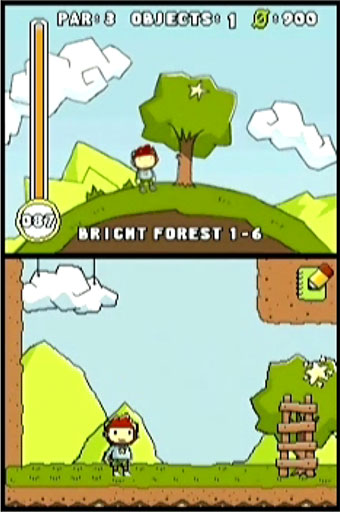
I'm sorry I haven't updated this blog much lately, as I've been planning for E3, got side-tracked with even more work once there, then was away visiting friends in LA (but that's a whole 'nother story). At any rate, I would still like to write about inFamous a great deal (my review is coming soon to TGR), and perhaps write about the experience of going to E3, but there are only so many hours in the day. In the meantime, here's a list of the best games I saw at E3 2009 (in no particular order):
-Brutal Legend:
Tim Schaefer's wonderful humor is in top form here in this story of a roadie going back in time to an age when the Gods of Rock ruled all. The combat system, the one element I was skeptical about, turns out to be fast, fluid, and a whole lot of fun. It's basically Zelda, but with a guitar instead of an ocarina and rocks all the more because of it. Easily the funniest game I've had the pleasure of playing since Schaefer's previous outing, Psychonauts.
-Scribblenauts:
My biggest surprise of the show. Solve puzzles by willing object into existence merely by typing them. Reportedly has tens of thousands of words in it. Objects I was able to summon include (but are not limited to): a jetpack, a hot-air balloon, shark repellent, a shotgun, a chainsaw, a sawed-off shotgun, a wall, a T-rex, land mines, and almost every other noun I know. The only time I managed to come up with something that wasn't in the game was when zombies were attacking me, in order to make myself less desirable to them I tried to see if I could conjure AIDS. Didn't work.
-Trine:
The Lost Vikings meets LittleBigPlanet meets Bionic Commando. Trine is a 2D side-scrolling action/puzzler with a twist; you can play as three characters and toggle between them. The wizard can summon boxes, the thief can grapple, and the knight can fight. The thing that makes Trine really unique is that you can play up to three players co-op, but you cannot inhabit a character if another player is already playing as them. As a result, playing with three players can be even more puzzling as playing with just the one as you'll all have to work together to find a way to get the bulky knight across some gaps and over platforms. If you play as one character, however, you'll have all the abilities available to you, but can only use one at a time. As a result, the physics based puzzles take on a life of their own with multiple solutions based on how many players are involved, making it feel like a whole new game.
Bayonetta:
In some ways, Bayonetta may not represent the most innovative game at the show, as it falls firmly into the conventional mechanics of what a hack-and-slash game entails: Learn combos, fight demons (or renegade angels, rather), earn points for power-ups, collect stuff, fight bosses, etc, etc... But sometimes originality is overrated. If it ain't broke, don't fix it. I'm tempted to use the analogy Bayonetta is to the hack-and-slash game what Mario Galaxy is to the 3D platformer i.e. it doesn't innovate in its mechanics, but takes everything that was great about the genre and polishes it to a science, then fills it with a healthy dose style. If it lives up to the demo, it could well be the most fun, stylish, addicting third-person hack-and-slash game ever made. This honestly wouldn't surprise me as I feel like the first DMC hold up tremendously well today and Kamiya-san has had 8 years to hone his craft and do for the genre what DMC did for it nearly a decade ago.
-Shadow Complex:
2D Uncharted meets Metroid. The mechanics are quite similar to Samus Aran's glory years where you explore a staggering maze in a 2D side-scrolling plane, though the aesthetic shares are more in common with Uncharted (right down to the same voice-actor for the lead). You play as a guy trying to rescue his kidnapped girlfriend from a hidden military complex in the jungle. The vent-crawling and platforming is like Metroid to a T, but it also has glorious hand to hand combat with finishing moves shown in full 3D that look straight out of Uncharted. It's a bit of an unlikely mix of inspiration, but the result is truly wonderful.
-Mass Effect 2:
Looks a lot like its predecessor in many ways, but when its predecessor is one of the finest action-RPGs ever made, that's not such a bad thing. The thing that has me really intrigued is that you can reportedly go to the final mission rather early in the game, but you won't stand a chance. Instead, you'll have to travel the galaxies searching for soldiers to go on this supposed suicide mission with you. Depending on who you get to join you and how you treat them, this final mission can play out in a multitude of different ways. This has me very, very intrigued.
-The Saboteur:
Sly Cooper meets Okami meets Hitman in WWII. Playing as a hedonistic, womanizing, race-car driving rebel, you're on a quest for revenge that happens to have you killing lots and lots of Nazis. The game looks to be an even mix of stealth and action as you climb buildings, get the drop on enemies, place explosives, and make fast getaways. It's also one of the most stylish games at the show where occupied territory is portrayed in glorious black and white with some of the best rain effects I've ever seen. Once you clear the missions in an area, it goes back to being in color, not unlike rejuvenating the plants in Okami. It's about time we have a game about killing Nazis that really takes advantage of the beauty of that era.
-Sin & Punishment 2:
I never played the first one, but this was one of the most fun demos I had the pleasure to play at this year's E3. It's basically an on-rails third-person shooter, ala Star Fox, but better. At first the art style turned me off, but after playing it, I learned to really not care. Much like Bayonetta, this isn't innovative, but it takes what was great about oldschool arcade gaming and makes it even better.
-Silent Hill: Shattered Memories:
See
here why Silent Hill never managed to really gel with me before. Shattered Memories seems to fix a lot of those issues with fluid controls, markers to show what items you can interact with, and nixes the dodgy combat in favor of some truly intense chases. Crashing through doors in this game reminds me of my very favorite bit of Mirror's Edge. I'm also intrigued by the psychological profile you take at the beginning and how it alters the experience. The only concrete piece of info I got was that it changes enemy appearance, so I'm hoping my arachnophobia makes the enemies spider-like. At any rate, it proved that a game can still be conventionally fun and still be scary as all hell.
-Alien Vs Predator:
A remake of a game I never played, but heard good things about. The behind closed doors demo I saw had you playing as a human, which should have been bland and like every other FPS horror in space shooter, but thanks to the aliens being a fantastic foe coupled with terrific lighting, poking around dark corridors using only your flare and flashlight to spot them sent chills down my spine. The bits I saw as Predator were even more interesting as you'd go from fighting the humans, picking them of stealthily one by one, to fast and furious combat with the aliens. The premise is silly and turned me off initially, but the concept of playing from hunter to hunted, to a neat little mixture of both looks to be a heckuva lot of fun.
Oh, and Uncharted 2 and God of War 3 looked fantastic, but I didn't bother to play them as they look like more of the first with better graphics. I liked their predecessors, so I'm sure I'll like them, just didn't feel compelled to try them, as I feel I know how they'll play already. But who knows? Maybe I'll be pleasantly surprised and they'll be even better than I'd thought.
Also, and I didn't include The Last Guardian only because it wasn't playable nor was any gameplay demo shown. When the trailer started running at the Sony Press Conference I got so giddy with excitement that I side-hugged my colleague next to me (poor Eddie). If more was known about this mysterious project, you could expect it near the top of my list. Same goes for Kojima's new Metal Gear and Castlevania projects.




















